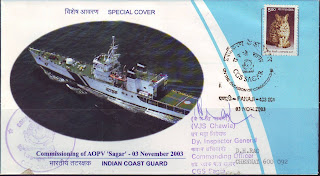 Date of Issue: November 03, 2003
Date of Issue: November 03, 2003Many thanks to Mr. D.H. Rao, Chennai; Chairman - Indian Naval Philatelic Society for sending me this valuable cover signed by the Commanding Officer of CGS Sagar, VJS Chawla.
The Coast Guard Ship (CGS) Sagar is the fourth ship in the advanced offshore patrol series built by Goa Shipyard Limited for Indian Coast Guard, the predecessors being Samar, Sangram and Sarang. The ship's keel was laid on July 6, 2000 by Vice Admiral JC De Silva, the then Director General of Indian Coast Guard. The ship was commissioned on November 3, 2003 by the then Defence Minister, Mr. George Fernandes at an impressive ceremony at Goa.
CGS Sagar has been equipped with state-of-the-art equipment. Her special features include an external fire fighting system for rendering assistance to ships at sea, pollution response equipment for controlling oil spillage and a system interfacing all the navigational sensors and equipment to a central computer and display known as chart station. The pride of the ship is the sophisticated Oto Melara super rapid-gun with anti-shipping and anti-aircraft capability. She is designed to operate Chetak helicopter as well as the indigenous Advanced Light Helicopters (ALH). She has been provided with two high speed boats enabling her to prosecute fleeing smugglers even in shallow waters.
At an economic speed, she can cover 6000 nautical miles and stay at sea for 20 days without any replenishment. Her weapons, sensors, communication systems and computerised action information system provide her a capability to perform the role of a command and control platform for the conduct of Coast Guard operations.
Click here to see Coast Guard miniature sheet issued on August 12, 2008.
Text source: mod.nic.in (Ministry of Defence, India)








































